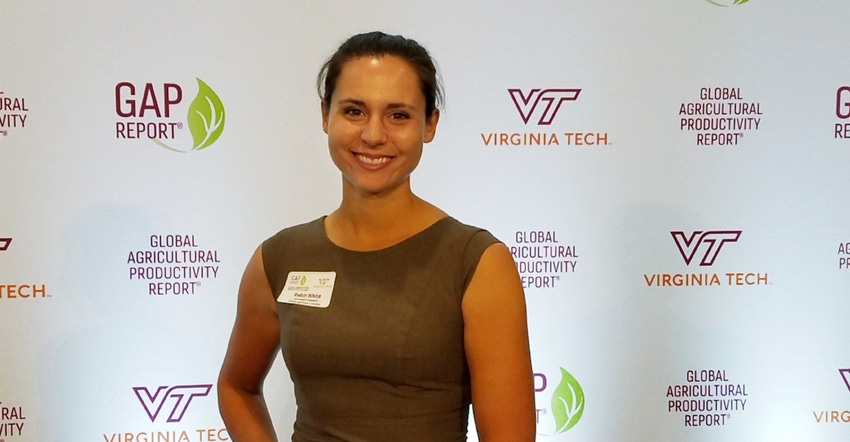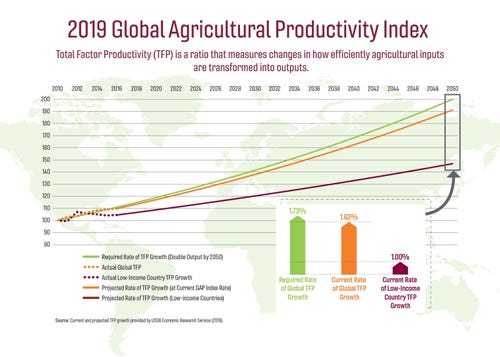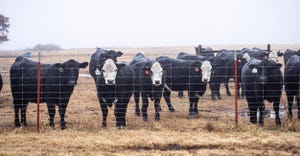Ag productivity slows in ag powerhouses
Agricultural productivity growth globally averages 1.63% annually, but rate needs to be 1.73%.

Productivity growth is strong in China and South Asia, but it is slowing in the agricultural powerhouses of North America, Europe and Latin America, according to the 2019 "Global Agricultural Productivity (GAP) Report: Productivity Growth for Sustainable Diets & More."
Virginia Tech University’s College of Agriculture & Life Sciences released the report as part of a side event at the World Food Prize Borlaug Dialogues on Oct. 16. The report is an annual overview of measuring efforts taken around the world to meet growing world food needs.
Jason Grant, Virginia Tech associate professor in agriculture and applied economics, said the report found that global agricultural productivity growth – increasing output of crops and livestock with existing or fewer inputs – is at an average annual rate of 1.63%. However, to meet the needs to produce food, feed, fiber and bioenergy for 10 billion people by 2050, the average annual growth rate needs to be 1.73%.
The report calls attention to the alarmingly low levels of productivity growth in low-income countries, where there also are high rates of food insecurity, malnutrition and rural poverty.
Agricultural productivity growth in low-income countries is rising at an average annual rate of just 1%. The U.N. Sustainable Development Goals call for doubling the productivity of the lowest-income farmers by 2030.
 “These productivity gaps, if they persist, will have serious ramifications for environmental sustainability, the economic vitality of the agriculture sector, and the prospects for reducing poverty, malnutrition and obesity,” said Ann Steensland, author of the 2019 GAP Report and coordinator of the GAP Report Initiative at Virginia Tech.
“These productivity gaps, if they persist, will have serious ramifications for environmental sustainability, the economic vitality of the agriculture sector, and the prospects for reducing poverty, malnutrition and obesity,” said Ann Steensland, author of the 2019 GAP Report and coordinator of the GAP Report Initiative at Virginia Tech.
The report calls for a strong focus on countries with high rates of population growth, persistent low levels of agricultural productivity and significant shifts in consumption patterns — the primary drivers of unsustainable agricultural practices, such as converting forests to cropland and rangeland.
“Decades of research and experience tell us that by accelerating productivity growth, it is possible to improve environmental sustainability while ensuring that consumers have access to the foods they need and want,” said Tom Thompson, associate dean and director of global programs for the Virginia Tech College of Agriculture & Life Sciences.
Productivity growth is generated by innovations such as precision agriculture technology and improved seeds as well as best practices for nutrient management and animal health. Attention to ecosystem services, such as pollination and erosion prevention, can increase and sustain productivity gains over time.
Steensland added that dogs and cats consume the same amount of calories as 62 million Americans. In addition, 1.3 million hectares around the world produce ornamental flowers or bulbs, raising concerns for sustainability and land use.
Animal agriculture in the U.S. has experienced productivity gains, dramatically reducing the environmental footprint of livestock production. According to Robin White, assistant professor of animal and poultry science at Virginia Tech, if livestock production in the U.S. was eliminated, total U.S. greenhouse gas emissions would decline by only 2.9%.
White noted that knowledge of methane’s contribution to the carbon footprint helps offer a better understanding of the natural carbon cycle and how agriculture shouldn’t be penalized the same as fossil fuels. “Anything we can do to enhance productivity will improve the carbon footprint but also the water and land footprint,” White said during a panel discussion following the report.
This includes how livestock can leverage genetic selection, reproductive efficiency and other methods to most effectively address environmental impact.
In the absence of further gains in total factor productivity, more land and water will be needed to increase food and agricultural production, which would strain a natural resource base already threatened by climate change.
Unable to afford higher-priced, nutrient-dense foods such as animal proteins and fruits and vegetables, consumers will rely on foods made from cheaper cereal grains for most of their calories, hence exacerbating skyrocketing obesity rates in adults and children.
The GAP Report describes six strategies for accelerating productivity growth: (1) investing in public agricultural research and development and extension, (2) embracing science- and information-based technologies, (3) improving infrastructure and market access, (4) cultivating partnerships for sustainable agriculture and nutrition, (5) expanding regional and global trade and (6) reducing post-harvest loss and food waste.
Thompson added that the message of GAP is the power of increasing total factor productivity through science-based solutions as a pathway to food security. He said this also offers new opportunities to be engaged in global conversations on solutions.
The GAP Report is available to view and download at www.globalagriculturalproductivity.org.
About the Author(s)
You May Also Like




.png?width=300&auto=webp&quality=80&disable=upscale)
